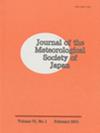himawai -8快速扫描大气运动矢量在中尺度资料同化中的应用
IF 1.6
4区 地球科学
Q3 METEOROLOGY & ATMOSPHERIC SCIENCES
引用次数: 8
摘要
快速扫描大气运动矢量(rs - amv)是利用日本气象厅(JMA)气象卫星中心从日本周边地区的Himawari-8快速扫描图像中开发的算法得到的。每隔10分钟对可见光通道(VIS)、近红外和红外通道(IR)、三个水蒸气吸收通道(WV)和二氧化碳吸收通道(CO2)这7个不同通道进行计算,图像三联体的时间间隔为VIS 2.5 min,其他6个通道为5 min。2016年6月,与常规使用的amv数量相比,数据量增加了20多倍。为了利用这些高分辨率资料在中尺度资料同化中改进短期预报,进行了资料验证和同化实验。rs - amv具有足够好的同化质量,并且与日本气象厅中尺度分析、无线电探空和风廓线观测的风总体一致。WV通道的误差略大于VIS和IR通道。相对于探空风,在VIS、IR和CO2的高水平观测到显著的负偏倚,而在WV的中高水平观测到轻微的正偏倚。利用JMA基于非静水模型的变分数据同化系统(JNoVA)对2016年6月的一次冷涡事件进行了数据同化实验。同化过程中,低涡经过日本北部地区,在12小时前的预报小时内风力预报略有改善。当在整个预测期间平均时,它们也显示出低水平的小改善。同化通道不同,结果略有不同,这可能是由于rs - amv在不同通道中的误差特性不同造成的。©作者2018。这是一篇由日本气象学会根据国际知识共享署名4.0 (CC by 4.0)许可(http://creativecommons.org/license/by/4.0)发布的开放获取文章。通讯作者:Michiko Otsuka,气象研究所预报部,1-1,Tsukuba,长山,茨城县305-0052,日本E-mail: motsuka@mri-jma.go.jp 1目前隶属于:日本气象厅,东京,日本数值预报部2目前隶属于:日本气象厅,清濑,日本气象卫星中心J-stage Advance发表日期:2018年3月23日日本气象学会学报,第96B卷,第111 - 131页,DOI:10.2151/jmsj。基于地球同步气象卫星himawai -8的气象与气候变化研究本文章由计算机程序翻译,如有差异,请以英文原文为准。
Characteristics of Himawari-8 Rapid Scan Atmospheric Motion Vectors Utilized in Mesoscale Data Assimilation
Rapid scan atmospheric motion vectors (RS-AMVs) were derived using an algorithm developed by the Meteorological Satellite Center of the Japan Meteorological Agency (JMA) from Himawari-8 rapid scan imagery over the area around Japan. They were computed every 10 min for seven different channels, namely, the visible channel (VIS), near infrared and infrared channels (IR), three water vapor absorption channels (WV), and CO2 absorption channel (CO2), from image triplets with time intervals of 2.5 min for VIS and 5 min for the other six channels. In June 2016, the amount of data was increased by more than 20 times compared to the number of routinely used AMVs. To exploit these high-resolution data in mesoscale data assimilation for the improvement of short-range forecasts, data verification, and assimilation experiments were conducted. The RS-AMVs were of sufficiently good quality for assimilation and consistent overall with winds from JMA’s mesoscale analyses, radiosonde, and wind profiler observations. Errors were slightly larger in WV than in VIS and IR channels. Significant negative biases relative to sonde winds were seen at high levels in VIS, IR, and CO2, whereas slightly positive biases were noticeable in WV at midto high levels. Data assimilation experiments with the JMA’s nonhydrostatic model based Variational Data Assimilation System (JNoVA) on a cold vortex event in June 2016 were conducted using RS-AMVs from seven channels. The wind forecasts improved slightly in early forecast hours before 12 hours in northern Japan, over which the vortex passed during the assimilation period. They also showed small improvements at low levels when averaged over the whole forecast period. The results varied slightly depending on the channels used for assimilation, which might be caused by different error characteristics of RS-AMVs in different channels. ©The Author(s) 2018. This is an open access article published by the Meteorological Society of Japan under a Creative Commons Attribution 4.0 International (CC BY 4.0) license (http://creativecommons.org/license/by/4.0). Corresponding author: Michiko Otsuka, Forecast Department, Meteorological Research Institute, 1-1 Nagamine, Tsukuba, Ibaraki 305-0052, Japan E-mail: motsuka@mri-jma.go.jp 1 Present affiliation: Numerical Prediction Division, Japan Meteorological Agency, Tokyo, Japan 2 Present affiliation: Meteorological Satellite Center, Japan Meteorological Agency, Kiyose, Japan J-stage Advance Published Date: 23 March 2018 Journal of the Meteorological Society of Japan, Vol. 96B, pp. 111−131, DOI:10.2151/jmsj.2018-034, 2018 Special Issue on Meteorology and Climate Change Studies by Using the Geostationary Meteorological Satellite Himawari-8 Journal of the Meteorological Society of Japan Vol. 96B 112
求助全文
通过发布文献求助,成功后即可免费获取论文全文。
去求助
来源期刊
CiteScore
6.70
自引率
16.10%
发文量
56
审稿时长
3 months
期刊介绍:
JMSJ publishes Articles and Notes and Correspondence that report novel scientific discoveries or technical developments that advance understanding in meteorology and related sciences. The journal’s broad scope includes meteorological observations, modeling, data assimilation, analyses, global and regional climate research, satellite remote sensing, chemistry and transport, and dynamic meteorology including geophysical fluid dynamics. In particular, JMSJ welcomes papers related to Asian monsoons, climate and mesoscale models, and numerical weather forecasts. Insightful and well-structured original Review Articles that describe the advances and challenges in meteorology and related sciences are also welcome.

 求助内容:
求助内容: 应助结果提醒方式:
应助结果提醒方式:


